History in the Making: Electric Trucks, Operational and In-Service
Honey Bucket (based in Puyallup, Washington) is a long-time pioneer in our industry in terms of leadership and innovation. This highly respected company has done it again with electric trucks! Honey Bucket put their first Chevrolet Silverado EV pickup truck in service in mid-July and three more are now ready to roll.
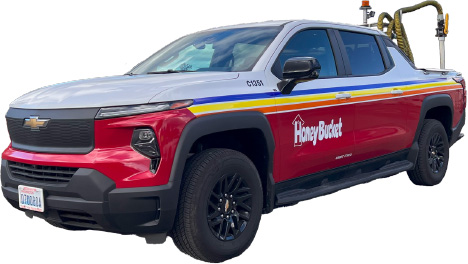
Ron Inman, Honey Bucket Vice President, who has a stellar 49-year career with the company, shared this exciting news. “Electric work trucks have moved from the research and development stage to the implementation stage, and we are excited to see what these can do!”
This decision was made after several years of diligent research. Always eager to explore new ideas, Ron attended the Green Transportation Summit and Expo (GTSE) for the past three years, with nearby Tacoma serving as the host city in August 2024. In addition, as a General Motors Fleet Buyer, Ron attended the GM Evolve Solutions Summit in Las Vegas in April 2024, where GM unveiled the Silverado EV (Electric Vehicle) to the attendees. After his first GM Summit in Phoenix in 2022, the leadership at Honey Bucket decided to make the leap and see how these might work out.
Not a Show Truck
Given Honey Bucket’s commitment to top-notch customer service, this was not going to be a “show truck” that served as a rolling billboard and advertised this vehicle as being environmentally friendly. As you can see below, the company configured this vehicle to serve the needs of the customer. With a small vacuum pump powered by an electric motor, a waste and water tank, and plenty of storage area in the cab for toilet paper and supplies, these are definitely “work trucks”!
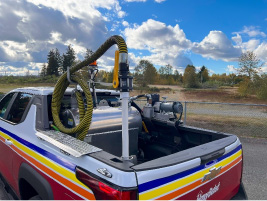 |
 |
When pulling onto an existing jobsite to inspect units or meet with a customer, an emergency service can be done, extra supplies can be provided, or a basic unit repair can be performed. When pulling a small trailer, one or more extra units can be delivered or a swap-out can be made. When pulling onto a prospective jobsite, unit(s) can be immediately put into place.
This do-it-all truck has an interesting past. Known by many names, “troubleshooter” is perhaps the best known. Popularized by industry pioneer Clyde Sansom in the 1970s, long-time employee Otis Cooksey, drove a similar truck to jobsites knowing that whatever the customer needed, he could provide—on the spot.
Learning Curve
As with any new technology, it takes time to become familiar with the concepts and ideas. Battery charging, distance traveled between charges, charging station availability and towing capacity were some of the items that Honey Bucket needed to investigate and resolve.
Charging
Honey Bucket Territory Manager Doug Gray has been driving the electric truck home and charging it overnight with a company-provided charging station. Over time, they have found that it takes several hours to fully charge the battery. Honey Bucket reimburses Doug for the power used.

Doug has found that if the truck battery indicator shows 20%, a 45-minute charge will increase the level to 80%. As part of this investigative process, he has been able to drive the truck for several days between charging, based on the number of miles driven. The GM-estimated range of the Silverado EV is 440 miles.
Here is the power bill for this truck for August 2024:
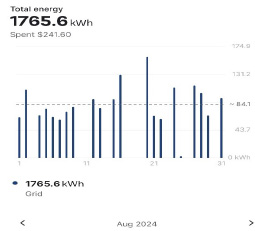
As the chart shows, the cost was $241.60. More importantly, the truck was not charged every evening. Given the average price of $4.65 per gallon for diesel fuel in the Seattle area in August, the power bill is the equivalent of 52 gallons of diesel fuel for an entire month for a comparable gas-powered Chevrolet truck. This is the equivalent of roughly 2 fill-ups of diesel—but for an entire month!
Doug has found that he has roughly a 500-mile driving range in the local area with a single charge. Several other advantages to the electric truck are that he can use it to support a Wi-Fi signal for their software system as well as charging batteries for tools and work lights.
The Honey Bucket EV is quite a conversation piece among customers and potential customers. Doug said that at a recent golf tournament where his company was a sponsor, “the crowd was amazed that when I lifted the hood, there was no engine, only additional storage.”

General Knowledge
Battery charging is constantly improving as this technology continues to evolve. Currently, there are 3 levels of charging. Level 1 charges through a common residential 120-volt AC outlet and will typically get 4 miles of driving range per hour of charge. Level 2 charges through 240-volt AC outlets and will get an average driving range of 32 miles per hour of charge. Direct Current Fast Charging (DCFC), also known as Level 3 chargers, converts AC to DC power and charging times are drastically faster. Depending on the vehicle, it means an average driving range of 75–400 miles per hour of charge.
The Silverado is equipped with the myChevrolet mobile app that helps to plan routes and provides compatible charging locations and availability in real time. Ron also states it soon becomes habit to look at the battery charge level indicator just as one does when looking at the fuel indicator in a gas-powered vehicle.

Towing Capacity
Ron reports that the truck has a maximum towing capacity of 10,000 pounds and can pull a ¾ ton trailer with 8 units with no problem. Obviously, the increased weight decreases the time between charges, and these are the type of observations that Honey Bucket continues to document as they gain familiarity with this new technology.
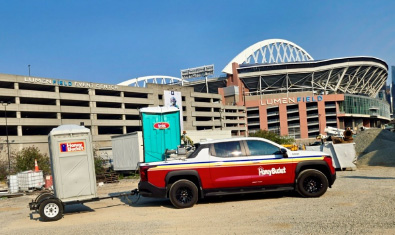
Cost Analysis
Depending on the option packages when comparing Chevrolet Silverado EV versus the Chevrolet Silverado WT (Work Truck), the cost of the electric truck is twice the price of the work truck. Electric trucks require less maintenance than internal combustion engines as EVs do not have engines, transmissions, or emissions control equipment. The U.S. Department of Energy conducted studies that show EVs cost about 6.1 cents per mile to maintain versus 10.1 cents per mile for an internal combustion engine vehicle. Owners of EVs may be eligible for federal tax incentive savings programs.
Depending on how the truck is used, it may take longer for the EV to pay for itself—but the longevity of these vehicles makes that a likely scenario.
Conclusions
Ron shares his thoughts on these vehicles so far:
- “This is not an all-solution vehicle. It has great limitations.”
- “We are still a long way from a route truck that will do a good day’s work.”
- “I hope the market will drive the future demand for electric and low or non-carbon vehicles, not government regulations.”
- “This effort takes us closer to real-life understanding of this technology.”
Final Thoughts
Thank you to Ron Inman and everyone at Honey Bucket for sharing their research and knowledge concerning electric trucks for use in our industry. I hope that this inspires other operators to follow their example and to begin to invest in electric vehicles. Honey Bucket’s leadership in our industry is commendable and very much appreciated.
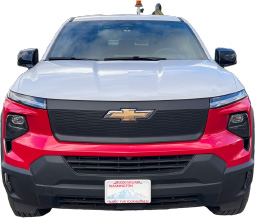
Fun Facts: History of Electric Vehicles
Electric vehicles have an amazing and generally unknown past. Here are some interesting points from Car and Driver magazine (published March 31, 2023):
- Sometime between 1832 and 1839: Robert Anderson from Scotland built a motorized carriage that moved a short distance and was not rechargeable.
- 1837: Robert Davidson, also from Scotland, built a prototype electric locomotive.
- 1859: Batteries that could be recharged were created.
- 1894: The first commercially viable electric vehicle was patented. Named the “Electrobat,” inventors Pedro Salom and Henry G. Morris used existing technology from battery-electric street cars and boats to develop this vehicle. It could travel over 20 miles per hour. Please celebrate with me here today in 2024, the 130th Anniversary of the Electrobat!
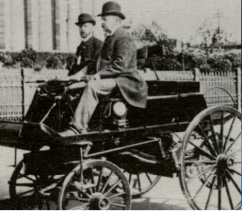
- From 1900 to 1912: One-third of all vehicles on the road in the U.S. were powered by electricity!
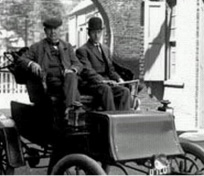
- Thomas Edison (at left in the photo above), inventor of the electric light, in his 1902 Studebaker Electric Vehicle.
- 1908: Ford launched the gasoline-powered Model T. It sold for $650 as compared to $1,750 for electric cars available at that time.
- 1920s: With the discovery of crude oil in Texas, gasoline prices fell dramatically, further steepening the decline in electric vehicles.
- 1960s and 1970s: The first shortages of oil in the U.S. began to renew interest in electric vehicles.
- 1971: Apollo 15 Mission to the Moon—The Lunar Rover, which allowed astronauts to cover greater distances for discovery, was an electric-powered vehicle.

- 2000s to today: Advancements continue.
